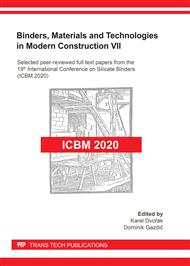[1]
Dvorkin, L.I.; Dvorkin O.L., Construction materials based on industrial wastes, Fenix, Rostov-on-Don, (2007).
Google Scholar
[2]
Butakova, M.D.; Gorbunov, S.P., Study of the influence of complex additives on properties of the gypsum-cement-puzzolan binder and concretes on its basis, Procedia Engineering 150 (2016), pp.1461-1467.
DOI: 10.1016/j.proeng.2016.07.082
Google Scholar
[3]
Pilehvar, S.; Cao, V.D.; Szczotok, A.M.; Carmona, M.; Valentini, L.; Lanzón, M.; Pamies, R.; Kjøniksen, A.-L., Physical and mechanical properties of fly ash and slag geopolymer concrete containing different types of micro-encapsulated phase change materials, Construction and Building Materials 173 (2018), p.28–39.
DOI: 10.1016/j.conbuildmat.2018.04.016
Google Scholar
[4]
Ferronskaya, A.V., Development of gypsum binder theory and practice, Construction Materials 2 (2000), pp.26-28.
Google Scholar
[5]
Parfenova L.M.; Bozylev V.V.; Shvedov A.P.; Vysotskaya M.N., Modes and methods for activation ash waste thermal power plants, Vestnik of Polotsk State University 8 (2016), pp.57-60.
Google Scholar
[6]
Akulova M.V.; Isakulov B.R., Mechanochemical activation and detoxification of industrial waste to produce binding light concrete, Vestnik VolgGASU 50(2013), pp.75-80.
Google Scholar
[7]
Kosach, A.F.; Berezkina U.V.; Shpakova I.N.; Danilov S.V., Efficiency of dry and wet methods of activation of binder using waste from production of pure quartz, Materials of the International Congress of FSBOU SibADI, 2016, pp.60-65.
Google Scholar
[8]
Yakovlev, G.I.; Gordina, A.F.; Polyanskikh, I.S.; Fischer, H.-B.; Ruzina, N.S.; Shameeva, E.V.; Kholmogorov, M.E., Gypsum compositions modified with Portland cement and metallurgic dust, Construction Materials 6 (2017), pp.76-79.
Google Scholar
[9]
Pervyshin, G.N.; Yakovlev, G.I.; Gordina, A.F.; Keriene, J.; Polyanskikh, I.S.; Fischer, H.-B.; Rachimova, N.R.; Buryanov, A.F., Water-resistant gypsum compositions with man-made modifiers, Procedia Engineering 172 (2017), pp.867-874.
DOI: 10.1016/j.proeng.2017.02.087
Google Scholar
[10]
Awoera, P., Adesina, A., A critical review on application of alkali activated slag as a sustainable composite binder, Case Studies in Construction Materials 11 (2019), pp.1-12.
DOI: 10.1016/j.cscm.2019.e00268
Google Scholar
[11]
Gordina, A.F.; Yakovlev, G.I.; Ruzina, N.S.; Drochitka, R.; Begunova, N.V.; Kuzmina N.V.; Begunova E.V., Activation of metallurgical dust to modify the properties of gypsum compositions, Construction Materials 10 (2019), pp.53-57.
DOI: 10.31659/0585-430x-2019-775-10-53-57
Google Scholar
[12]
Zvironaite, Ja.; Pundiene, I.; Gaiduchis, S.; Kizinievich, V., Effect of different pozzolana on hardening process and properties of hydraulic binder based on natural anhydrite, Journal of Civil Engineering and Management 18 (2012), pp.530-536.
DOI: 10.3846/13923730.2012.702126
Google Scholar
[13]
Gordina, A.F., Composite materials based on calcium sulphate with disperse modifiers: PhD thesis, Kalashnikov Izhevsk State Technical University, (2016).
Google Scholar


